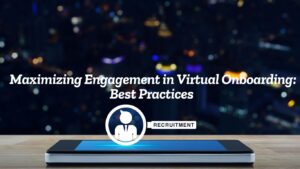
The world of work has undergone a seismic shift, and with it, the onboarding process. Physical offices and in-person handshakes are no longer the default, making virtual onboarding the new normal for many organizations. While offering undeniable benefits like cost-effectiveness and scalability, virtual onboarding presents unique challenges when it comes to keeping new hires engaged and enthusiastic. A lackluster virtual onboarding experience can lead to disengagement, decreased productivity, and even early attrition.
We’ll explore strategies covering everything from pre-boarding communication to ongoing support, ensuring your new hires feel welcomed.
Laying the Foundation: Pre-Boarding Bliss
The onboarding journey begins long before the first day. The pre-boarding phase is crucial for setting expectations and fostering a sense of anticipation.
- Personalized Welcome Video: A short, authentic video from the team or even the CEO introduces the company culture and expresses excitement about the new hire joining.
- Team Introductions: Provide photos and brief bios of team members they’ll be working with, along with their roles and responsibilities. This helps new hires put faces to names and feel more connected from the start.
- First-Week Schedule: Outline their first week’s schedule with specific meetings, training sessions, and tasks. This eliminates uncertainty and allows them to mentally prepare.
- Managerial Touchpoints: Encourage managers to reach out to new hires before their first day. A quick phone call or video chat to introduce themselves, answer questions, and express excitement can make a significant difference.
- Buddy System Implementation: Assign a “buddy” – a current employee who can act as a mentor and resource for the new hire.
The Virtual Onboarding Experience: Making it Engaging and Interactive
The core virtual onboarding experience should be more than just a series of webinars and online modules. It needs to be interactive, engaging, and personalized to ensure new hires actively participate and retain information.
- Chunk it Down: Avoid information overload. Break down the virtual onboarding process into manageable chunks spread out over several days or weeks. This allows new hires to absorb information at their own pace and prevents burnout.
- Interactive Training Modules: Move beyond passive learning. Incorporate interactive elements like quizzes, polls, group discussions, simulations, and gamification to keep new hires actively engaged. Utilize online tools that facilitate collaboration and knowledge sharing.
- Personalized Learning Paths: Tailor the virtual onboarding experience to the specific role and needs of each new hire. Use assessments to identify knowledge gaps and provide customized learning paths that address those gaps.
- Technology is Key: Invest in robust and user-friendly technology. Ensure that your virtual onboarding platform is reliable, accessible, and integrates seamlessly with your other business systems. Provide technical support and training to new hires to help them navigate the technology.
Fostering Connection and Culture Remotely
One of the biggest challenges of virtual onboarding is fostering a sense of connection and belonging among new hires. It’s crucial to create opportunities for them to connect with their colleagues, learn about the company culture, and feel like they are part of a team.
- Virtual Team Building Activities: Organize virtual team building activities that promote collaboration, communication, and fun. These could include online games, virtual escape rooms, virtual cooking classes, or even simple icebreaker activities.
- Regular Check-Ins: Managers should schedule regular one-on-one check-ins with new hires to provide support, feedback, and guidance. These check-ins should be more than just performance reviews; they should be opportunities to build rapport and foster a sense of trust.
- Encourage Open Communication: Create a culture of open communication where new hires feel comfortable asking questions, sharing ideas, and providing feedback. Use communication tools like Slack or Microsoft Teams to facilitate real-time communication and collaboration.
- Virtual Mentorship Programs: Pair new hires with experienced employees who can provide guidance, support, and mentorship. This can help new hires navigate the company culture, develop their skills, and build their professional network.
Measuring Success and Continuous Improvement
Virtual onboarding isn’t a one-and-done process. It’s important to continuously measure its effectiveness and adjust as needed.
- Gather Feedback: Solicit feedback from new hires throughout the virtual onboarding process. Use surveys, interviews, and focus groups to gather insights into their experiences and identify areas for improvement.
- Track Key Metrics: Track key metrics such as completion rates, engagement levels, and employee retention rates. This data can help you assess the effectiveness of your virtual onboarding program and identify areas where you need to adjust.
- Stay Up to Date: The world of virtual onboarding is constantly evolving. Stay up to date on the latest trends and best practices by attending industry conferences, reading relevant articles, and networking with other professionals.
How FlexiEle can help in virtual onboarding?
- Stay in the Loop: Get email notifications for every step of the process—from creating offers to welcoming new joiners.
- Effortless Updates: When a candidate becomes a full-time employee, all their details and documents are automatically added to the employee master—no extra effort needed.
- Say Goodbye to Duplicates: Built-in checks make sure no duplicate candidate profiles are created, keeping your data clean and organized.
- Easy Access to Documents: Need the appointment letter or joining form? They’re always available for download in the Employee Documents Section.
- Welcoming New Employees: Before onboarding even starts, HR can share exciting content about the organization to make employees feel engaged and welcome.
Conclusion
Virtual onboarding is a critical component of a successful remote work strategy. By implementing these best practices, you can create a virtual onboarding experience that is engaging, informative, and empowering for your new hires. Remember, a positive virtual onboarding experience can significantly impact employee engagement, productivity, and retention, ultimately contributing to the success of your organization.

